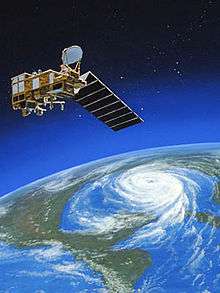NPOESS

The National Polar-orbiting Operational Environmental Satellite System (NPOESS) was to be the United States' next-generation satellite system that would monitor the Earth's weather, atmosphere, oceans, land, and near-space environment. NPOESS satellites were to host proven technologies and operational versions of sensors that are currently under operational-prototyping by NASA. The estimated launch date for the first NPOESS satellite, "C1" or "Charlie 1" was around 2013. Issues with sensor developments were the primary cited reason for delays and cost-overruns.
NPOESS was to be operated by the NOAA / NESDIS / NPOESS Program Executive Office Flight Operations at the NOAA Satellite Operations Facility (NSOF) in Suitland, MD. Northrop Grumman Aerospace Systems (NGAS) was the primary system integrator for the NPOESS project. Raytheon, Ball Aerospace & Technologies Corp. and Boeing were developing the sensors.
NPOESS was to be a replacement for both the United States Department of Defense's DMSP and the NOAA Polar Operational Environmental Satellites (POES) series. The NPOESS Preparatory Project (NPP) was planned as a pathfinder mission for NPOESS. The project had to go through three Nunn-McCurdy reviews, Congressional hearings that are automatically triggered when a program goes over budget by more than 25%.[1] It was launched five years behind schedule, on October 28, 2011.[2][3]
The White House announced on February 1, 2010, that the NPOESS satellite partnership was to be dissolved, and that two separate lines of polar-orbiting satellites to serve military and civilian users would be pursued instead:[4]
- The NOAA/NASA portion is called the Joint Polar Satellite System (JPSS). The JPSS-1 spacecraft will be constructed by Ball Aerospace & Technologies Corp., under a fixed price contract of $248 million with a performance period through Feb. 1, 2015.[5] The common ground system will be constructed by Raytheon. Its launch has slipped to 2017.[6]
- The Defense Department's portion is called DWSS (Defense Weather Satellite System).[7] In January 2012, the US Air Force cancelled the program.[8]
References
- ↑ 109th Congress, 2nd Session, House of Representatives. Hearing before the Committee on Science, The future of NPOESS: results of the Nunn-McCurdy review of NOAA's weather satellite program. June 8, 2006. Serial No. 109-53. Government Printing Office, Washington, D.C., 2007
- ↑ "JPSS satellite delays risk loss of global climate data continuity". Climate Science Watch. 10 July 2012. Retrieved 12 Feb 2013.
- ↑ "Suomi NPP Mission Overview". NASA. Retrieved 12 Feb 2013.
- ↑ "White House Dissolves NPOESS Satellite Partnership". SpaceNews. 2 Feb 2010. Retrieved 12 Feb 2013.
- ↑ "NASA AWARDS CONTRACT FOR JPSS-1 SPACECRAFT". NASA. 23 Sep 2010. Retrieved 12 Feb 2013.
- ↑ "U.S. Satellite Plans Falter, Imperiling Data on Storms". New York Times. October 26, 2012. Retrieved 12 Feb 2013.
- ↑ "Outlines of Pentagon Weather Satellite Plan Starting To Emerge". SpaceNews. 30 Jun 2010. Retrieved 12 Feb 2013.
- ↑ "Proposed next-generation weather satellites get the ax". Spaceflight Now. January 24, 2012.
External links
| Wikimedia Commons has media related to NPP (satellite). |